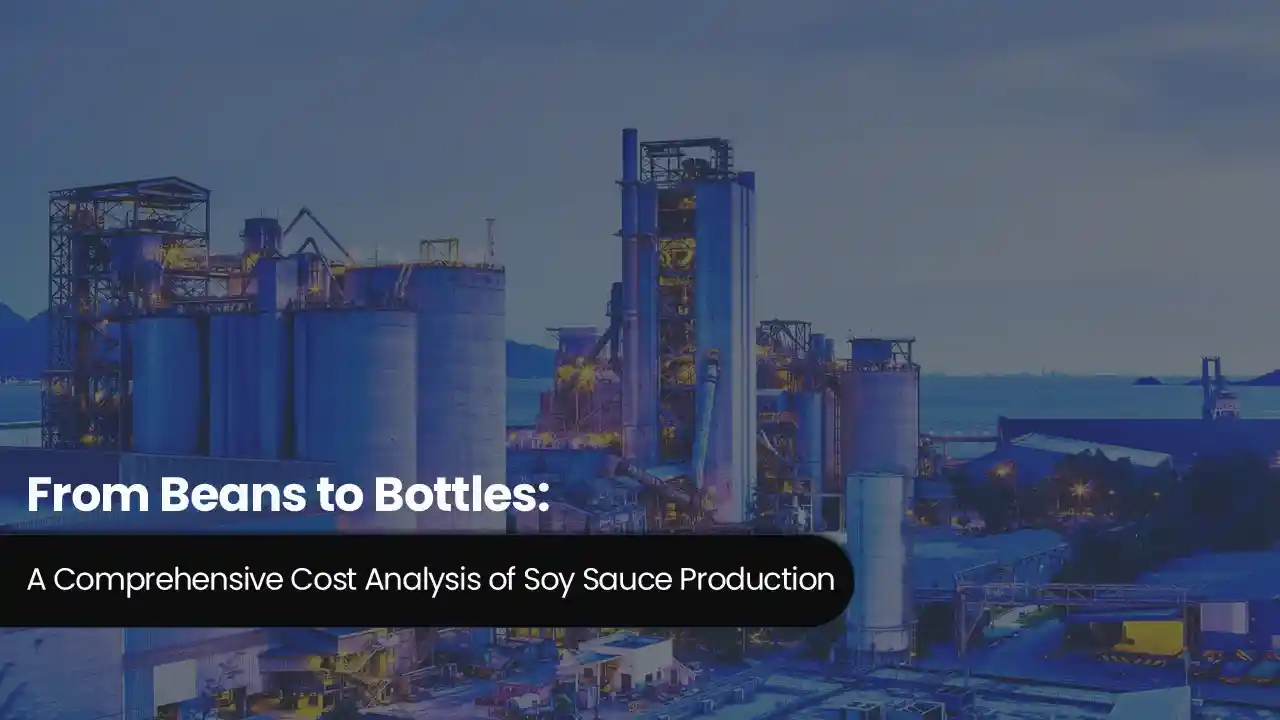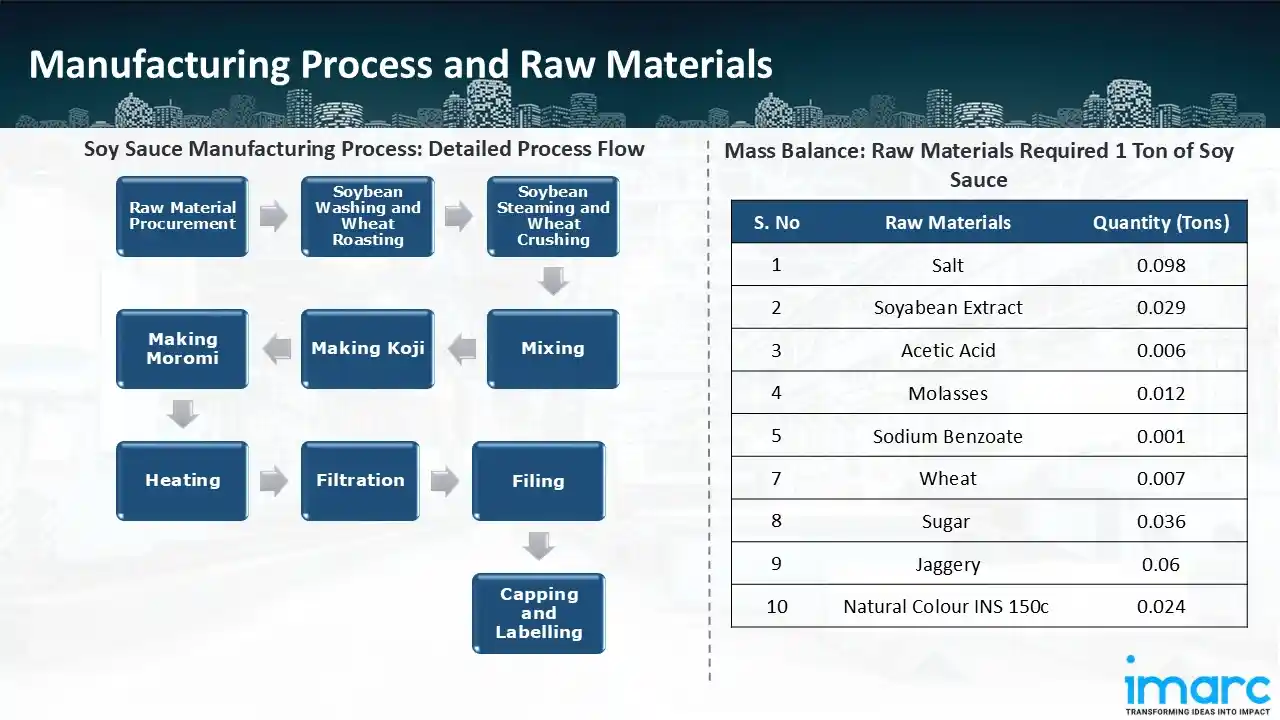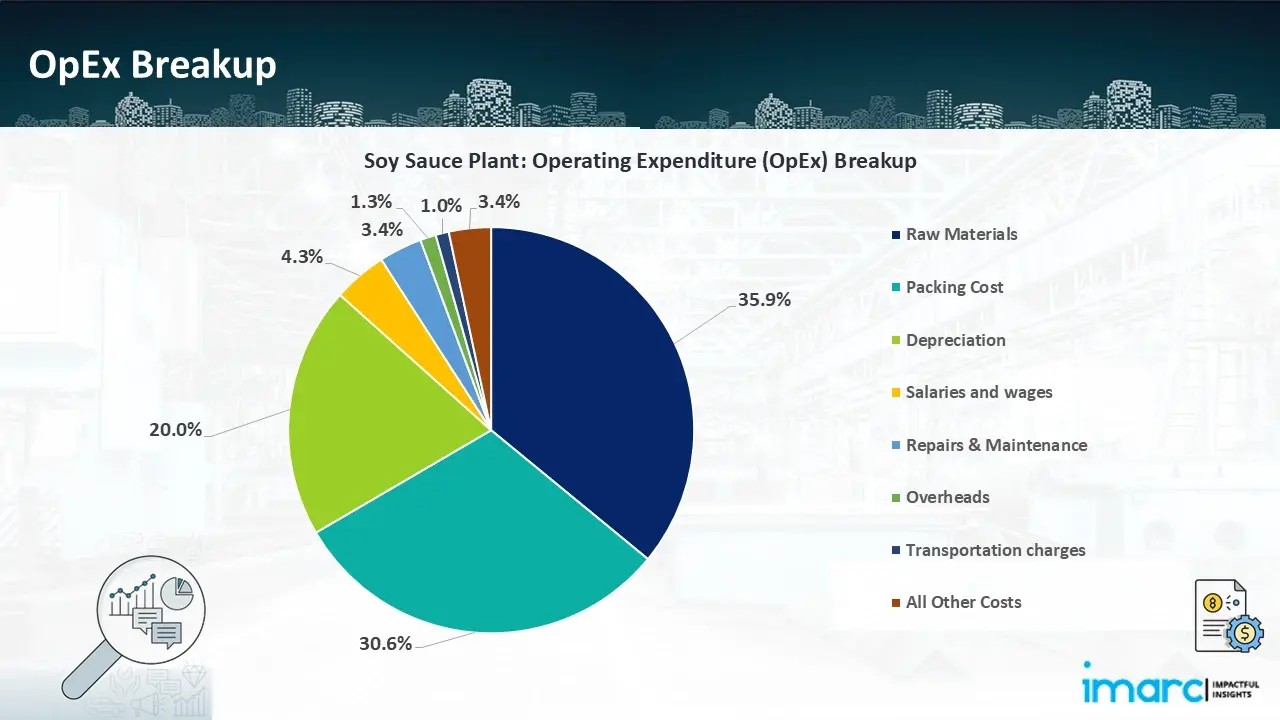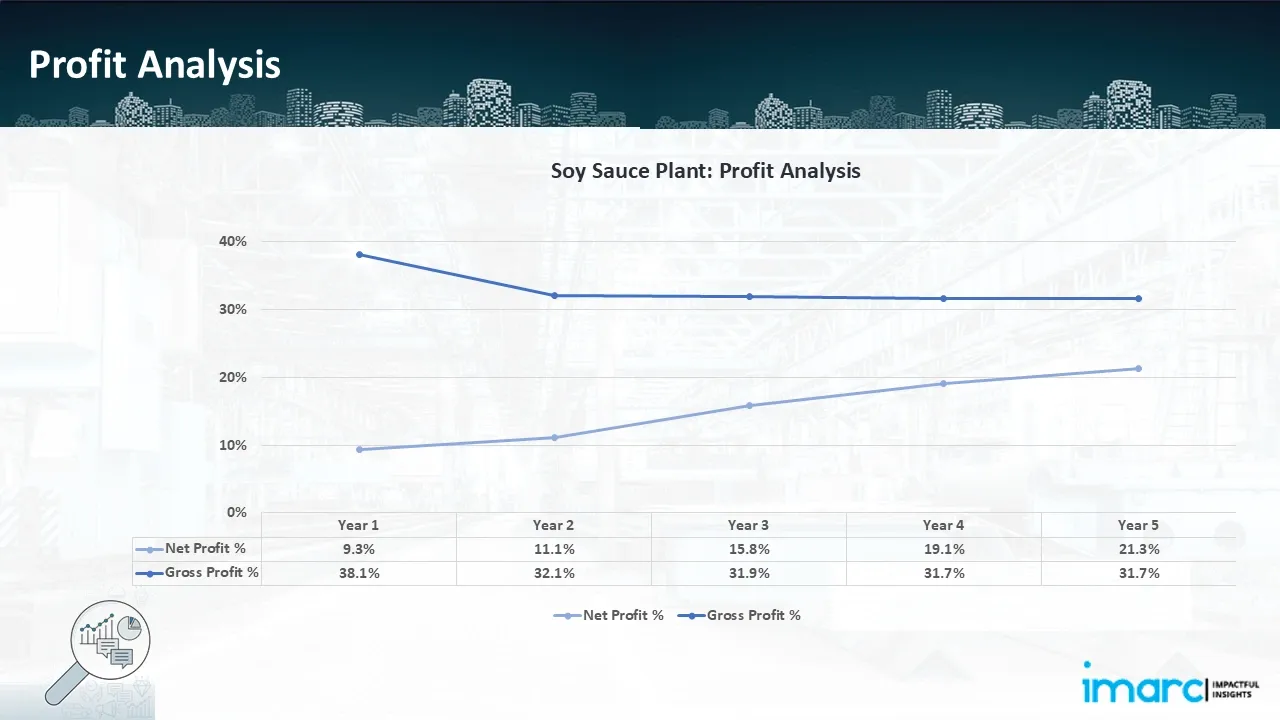From Beans to Bottles: A Comprehensive Cost Analysis of Soy Sauce Production

Soy sauce is a liquid condiment used extensively in cooking and seasoning food. Produced from fermented soybeans, wheat, salt, and water, it provides a deep umami taste that can be used to enhance different foods. It is a common ingredient in Asian cooking and has become popular worldwide in marinades, stir-fries, dips, and processed foods. Come in various forms including light, dark, and low-sodium, soy sauce meets the different consumer tastes and nutritional requirements, rendering it a vital ingredient in the food industry. According to an IMARC study, the global soy sauce market size reached US$ 78.2 billion in 2024. Looking ahead, the market is expected to grow at a CAGR of approximately 4.29% from 2025 to 2033, reaching a projected size of US$ 114.1 billion by 2033. The market for soy sauce is fuelled by growing worldwide demand for Asian food, and the rising trend of global flavors in food service and home cooking. The growing food and beverage industry, especially in ready-to-eat foods, snacks, and condiments, also enhances market growth. Growing health consciousness has generated demand for low-sodium and organic soy sauce types. Furthermore, the rise in e-commerce and retail channels of distribution has enhanced availability, propelling greater sales. Technological innovation in fermentation technologies and clean-label manufacturing is also driving the industry. Further, the growing trend of vegan and plant-based food eating supports the consumption of soy sauce as one of the primary umami intensifiers. New markets in Asia-Pacific and North America are experiencing greater uptake because of increasing urbanization and evolving consumer trends. Sustainability initiatives like eco-friendly packaging and non-GMO ingredients also propel growth and appeal to health-oriented consumers.
Trending Insights on Soy Sauce: Latest News and Developments
- In June 2024, Kikkoman Foods, Inc. commenced construction of a new USD 560 million manufacturing facility in Wisconsin, USA. The plant will manufacture soy sauce and other seasonings, such as teriyaki sauce.
- In January 2024, Kikkoman is making its debut with a black soy sauce designed specifically for the Indian market. After recognising that many Indians expect Chinese and Pan-Asian dishes to have a rich, dark colour that they find visually appealing, Kikkoman of Japan spent four years developing a natural dark soy sauce, which is different from its well-known classic naturally brewed Kikkoman Soy Sauce.
- In October 2023, Chiba Shoyu Co., an old soy sauce producer in Katori, Chiba Prefecture, has begun an effort to get traditional Japanese soy sauce production to take root in India with a proposal to carry out a pilot project on naturally brewing soy sauce in India.
- In March 2023, Solenis and Diversey Holdings, Ltd. said that they have agreed to a definitive merger agreement wherein Solenis would acquire Diversey in a cash transaction valued at an enterprise value of around USD 4.6 billion. Diversey will be privatized upon merger completion.
Case Study on Cost Model of Soy Sauce Manufacturing Plant
Objective: One of our clients has approached us to conduct a feasibility study for establishing a mid to large-scale soy sauce manufacturing plant in India. We have developed a detailed financial model for the plant's setup and operations. The proposed facility is designed with a production capacity of 10 tons of soy sauce per day.
Manufacturing Process: The production of soy sauce starts with the use of quality raw materials such as soybeans, wheat, and salt. The soybeans are washed thoroughly and steamed, while the wheat is roasted and ground. The ingredients are then blended in equal quantities before being mixed with a brine of saltwater, which acts as a preservative. Koji mold is added to the mixture, which triggers enzymatic activity that hydrolyzes proteins into umami-rich amino acids, creating a mash called "moromi." The moromi is fermented and aged for a few months, during which enzymes, yeast, and bacteria create the characteristic taste and smell of soy sauce. After aging, the moromi is pressure-filtered to obtain raw soy sauce liquid. The liquid that is extracted is then subjected to heat treatment for sterilization, which improves its color, aroma, and flavor. The purified soy sauce is then pumped into the filling section, where glass bottles are filled by automated machinery. A capping machine caps the bottles, followed by labeling for brand recognition. Lastly, the packaged bottles are loaded into carton boxes manually or by a carton-filling machine, ready for distribution. This highly controlled production method secures the quality and consistency of the soy sauce, rendering it as a popular condiment for both classic and contemporary cuisines.

Mass Balance and Raw Material Required: The primary raw materials utilized in the soy sauce manufacturing plant largely include salt, soyabean extract, acetic acid, molasses, sodium benzoate, wheat, sugar, jaggery, and natural colour INS 150c. To produce 1 ton of soy sauce, we require 0.098 tons of salt, 0.029 tons of soyabean extract, 0.006 tons of acetic acid, 0.012 tons of molasses, 0.001 tons of sodium benzoate, 0.007 tons of wheat, 0.036 tons of sugar, 0.06 tons of jaggery, and 0.024 tons of natural colour INS 150c.
List of Machinery:
The following equipment was required for the proposed plant:
- Cooling Machine
- Mixing Screw
- Inoculation Machine
- Pneumatic Conveying System
- Disc Koji Making Machine DN9000
- Steel Structure
- Turntable Assembly
- Stirring Part
- Stirring Part Lifting Device
- Discharge Machine Part
- Lifting Device of Discharging Machine
- Flashlight
- Roof Heating Part
- Wind Tunnel
- Heat Exchanger
- Adjust the Damper
- Spray Humidification
- Fan 4-72 10#C
- Water Treatment
- Sauce Storage Tank
- Semi-Finished Product Storage Tank
- Press Equipment
- Continuous Armband Machine
- Complete Set of Food-Grade Pipeline Valves
- Filling Machine
- Capping Machine
- Labeling Machine
- Laser Coding Machine
- Conveyer Motor
- Power Distribution Cabinets, Control Cabinets, and PLC Control Cabinet, etc.
Techno-Commercial Parameter:
- Capital Investment (CapEx): Capital expenditure (CapEx) in a manufacturing plant includes various investments essential for its setup and long-term operations. It covers machinery and equipment costs, including procurement, installation, and commissioning. Civil works expenses involve land development, factory construction, and infrastructure setup. Utilities such as power, water supply, and HVAC systems are also significant. Additionally, material handling systems, automation, environmental compliance, and safety measures are key components. Other expenditures include IT infrastructure, security systems, and office essentials, ensuring operational efficiency and business growth.
- Operating Expenditure (OpEx): Operating expenditure is the cost incurred to operate a manufacturing plant effectively. Opex in a manufacturing plant typically includes the cost of raw materials, utilities, depreciation, taxes, packing cost, transportation cost, and repairs and maintenance. The operating expenses are part of the cost structure of a manufacturing plant and have a significant effect on profitability and efficiency. Effective control of these costs is necessary for maintaining competitiveness and growth.

- Profitability Analysis Year on Year Basis: The proposed soy sauce plant, with a capacity of 10 tons of soy sauce per day, achieved an impressive revenue of US$ 2.06 million in its first year. We assisted our client in developing a detailed cost model, which projects steady growth, with revenue reaching rising throughout the projected period. Moreover, gross profit margins reduced from 38.1% to 31.7% during the period, and net profit margins rise from 9.3% to 21.3%, highlighting strong financial viability and operational efficiency.

Conclusion
Our soy sauce manufacturing plant's financial model was meticulously modelled to satisfy the client's requirements. It provided a thorough analysis of production costs including capital expenditures, manufacturing processes, raw materials, and operating costs. The model predicts profitability while accounting for market trends, inflation, and any shifts in the price of raw materials. It was created especially to satisfy the demand of producing 10 tons of soy sauce per day. Our commitment to offering precise, client-cantered solutions that ensure the long-term success of significant industrial projects by giving the client useful data for strategic decision-making is demonstrated by this comprehensive financial model.
IMARC's Financial Model Expertise: Helping Our Clients Explore Industry Economics
IMARC is a global market research company that offers a wide range of services, including market entry and expansion, market entry and opportunity assessment, competitive intelligence and benchmarking, procurement research, pricing and cost research, regulatory approvals and licensing, factory setup, factory auditing, company incorporation, incubation services, recruitment services, and marketing and sales.
Brief List of Our Services: Market Entry and Expansion
- Market Entry and Opportunity Assessment
- Competitive Intelligence and Benchmarking
- Procurement Research
- Pricing and Cost Research
- Sourcing
- Distribution Partner Identification
- Contract Manufacturer Identification
- Regulatory Approvals, and Licensing
- Factory Setup
- Factory Auditing
- Company Incorporation
- Incubation Services
- Recruitment Services
- Marketing and Sales
Under our factory setup services, we assist our clients in exploring the feasibility of their plants by providing comprehensive financial modeling. Additionally, we offer end-to-end consultation for setting up a plant in India or abroad. Our financial modeling includes an analysis of capital expenditure (CapEx) required to establish the manufacturing facility, covering costs such as land acquisition, building infrastructure, purchasing high-tech production equipment, and installation. Furthermore, the layout and design of the factory significantly influence operational efficiency, energy consumption, and labor productivity, all of which impact long-term operational expenditure (OpEx). So, every parameter is covered in the analysis.
At IMARC, we leverage our comprehensive market research expertise to support companies in every aspect of their business journey, from market entry and expansion to operational efficiency and innovation. By integrating our factory setup services with our deep knowledge of industry dynamics, we empower our clients to not only establish manufacturing facilities but also strategically position themselves in highly competitive markets. Our financial modeling and end-to-end consultation services ensure that clients can explore the feasibility of their plant setups while also gaining insights into competitors' strategies, technological advancements, and regulatory landscapes. This holistic approach enables our clients to make informed decisions, optimize their operations, and align with sustainable practices, ultimately driving long-term success and growth.
Our Clients
Contact Us
Have a question or need assistance?
Please complete the form with your inquiry or reach out to us at
Phone Number
+91-120-433-0800+1-201-971-6302
+44-753-714-6104










